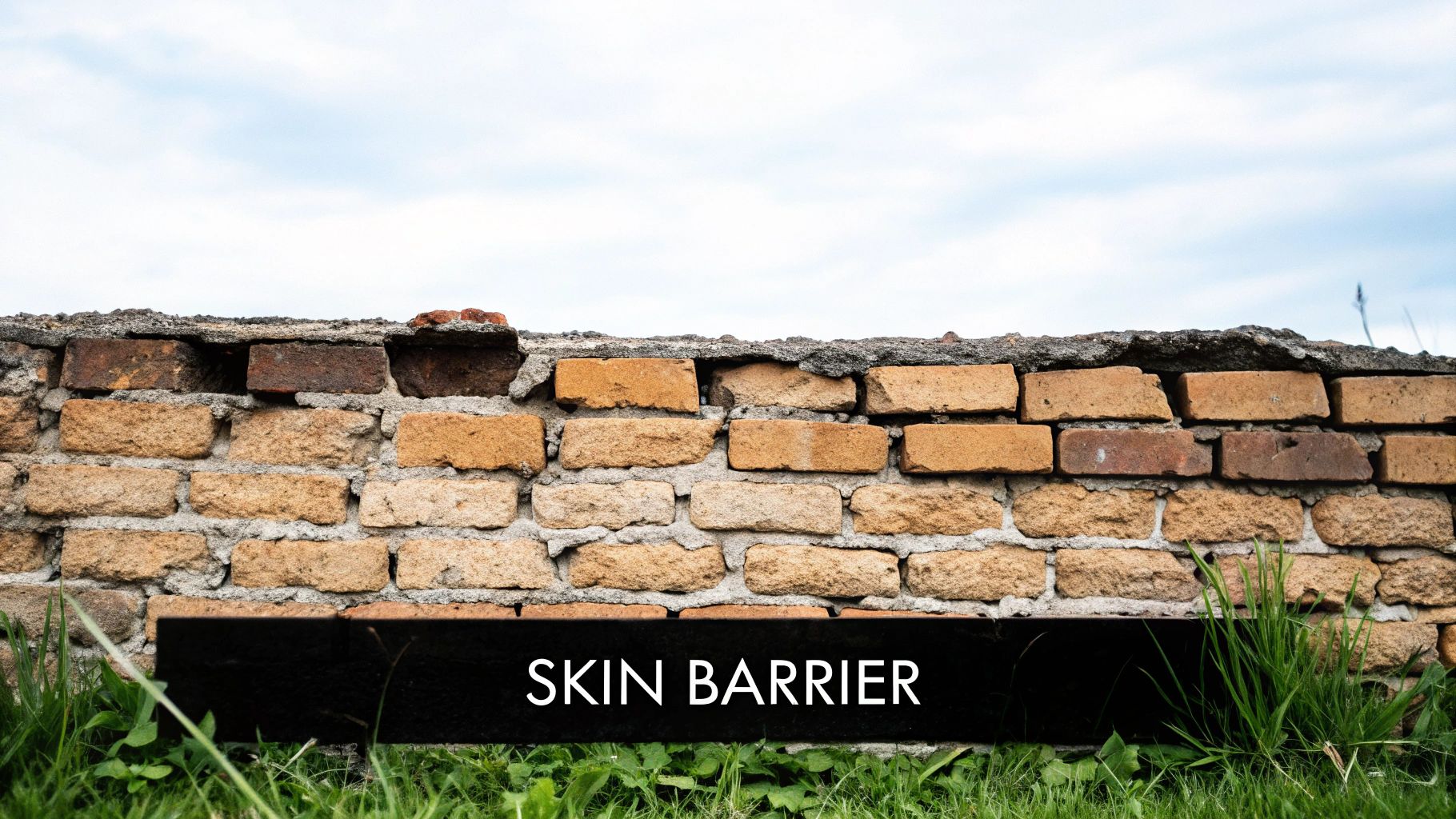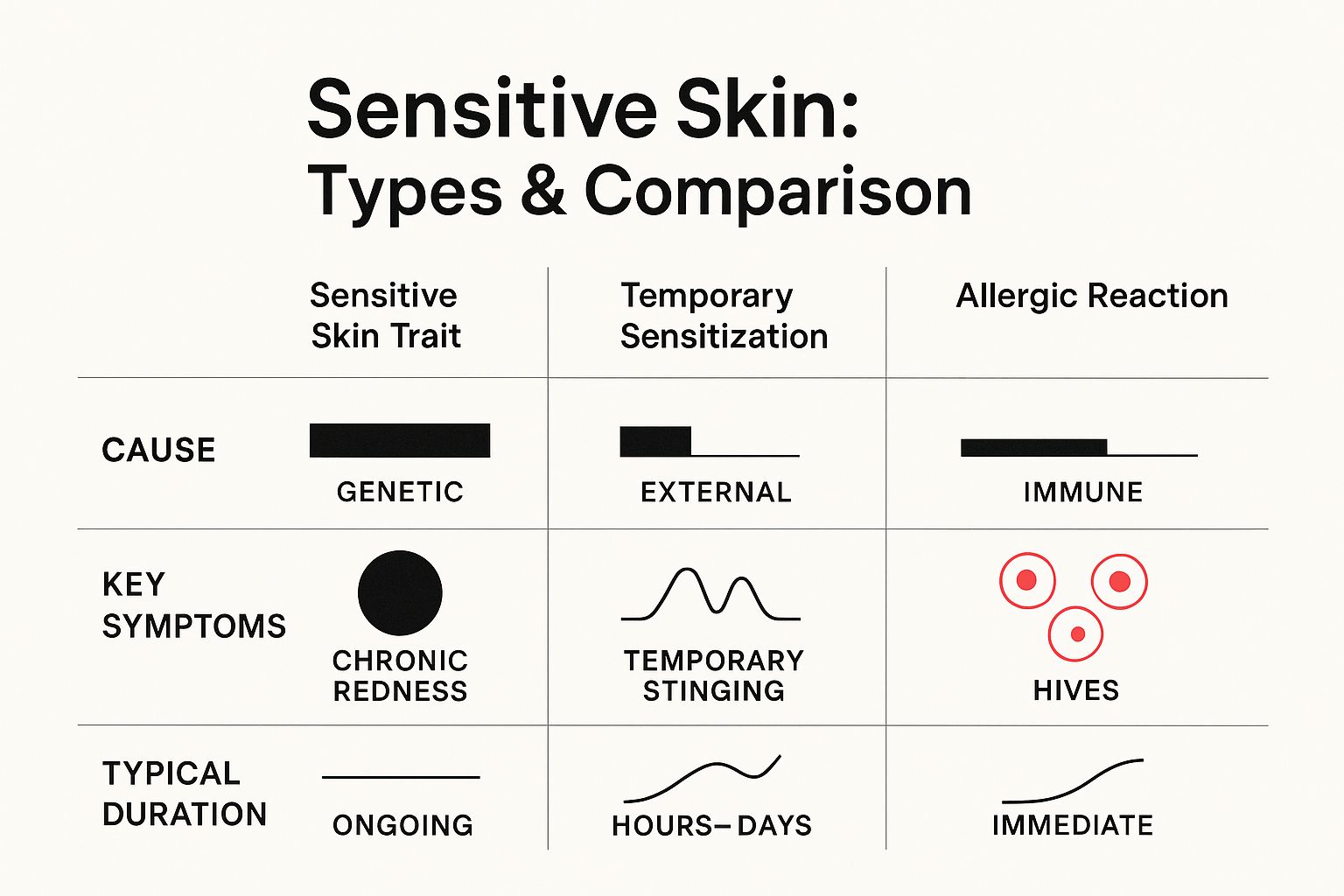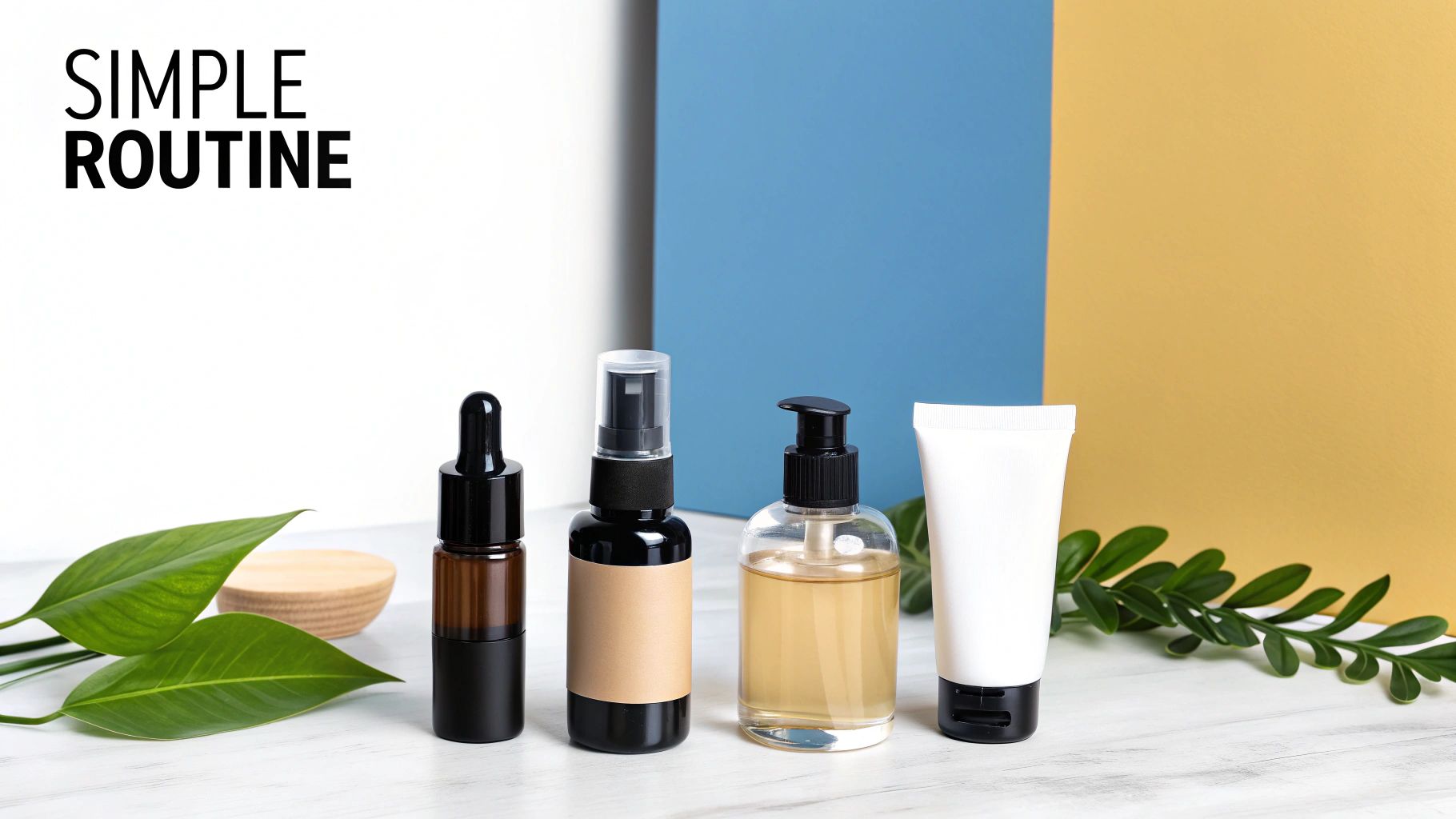What Causes Skin Sensitivity? A Practical Guide to Finding Calm
- Web Dev
- Oct 21
- 14 min read
Let's get right to the heart of it: what really causes your skin sensitivity? At its core, it's your skin sending out an SOS that its protective barrier has been compromised.
Think of a healthy skin barrier as a sturdy brick wall around your house. It's expertly built to keep all the good stuff (like moisture) in, and all the bad stuff (like pollution and irritants) out. But for those of us with sensitive skin, that wall has a few missing bricks. This allows aggressors to sneak in and precious moisture to escape, leading to that frustrating sting, tightness, or redness you know all too well.
Your Quick Guide to Understanding Sensitive Skin

If you’ve ever felt that frustrating sting, uncomfortable tightness, or seen that tell-tale redness flare up out of nowhere, you are far from alone. This guide is your practical roadmap, designed to walk you through all the reasons why your 'wall' might be a little weakened, from your genetics to the air you breathe.
Grasping this one core concept is the first, and most empowering, step you can take. It’s the key to finally building a routine that not only soothes and protects but brings you genuine, lasting comfort. You're not just dealing with random reactions anymore; you're learning to speak your skin's unique language.
By recognising your personal triggers and understanding the health of your skin barrier, you shift from feeling helpless to feeling in control. It’s all about moving from a state of constant reaction to one of proactive, intentional care. You get to be in the driver's seat.
The Widespread Nature of Skin Sensitivity
While 'sensitive skin' isn't a formal medical diagnosis here in the UK, if you feel like everyone you know has it, you're not wrong. Self-reported surveys paint a very clear picture: it's incredibly common.
In European populations, for instance, a staggering 74% of women and 38% of men report having at least some degree of skin sensitivity. These numbers show just how many of us are navigating this daily. You can find more fascinating insights into sensitive skin prevalence on qvskincare.co.uk.
This isn’t some niche concern; it’s a shared experience. And understanding the 'why' behind your sensitivity is your secret weapon for managing it effectively. Your skin is simply communicating its needs through these signals of discomfort.
Your skin’s sensitivity isn't a flaw—it's a messenger asking for thoughtful care. By listening to it, you can provide the support it needs to feel calm, strong, and resilient.
This entire journey is about forging a new relationship with your skin, one founded on awareness and gentle, consistent support. The factors that influence sensitivity tend to fall into two main camps:
Internal Factors: These are the elements that come from within your body. Think genetic predispositions, hormonal fluctuations, and even your stress levels.
External Triggers: These are the influences from your environment, from the skincare products you choose and the weather outside, to pollution and your daily habits.
By exploring both sides of the coin, you can build a complete, 360-degree picture of what your unique skin truly needs to thrive.
Common Triggers for Skin Sensitivity at a Glance
To help you get started on your journey of discovery, it's useful to see the most common culprits laid out clearly. Think of this as your initial checklist for potential triggers. As you read, ask yourself, "Could this be what's affecting my skin?"
Trigger Type | Specific Examples |
|---|---|
Environmental | UV radiation, extreme cold or heat, wind, pollution, hard water |
Skincare & Cosmetics | Harsh cleansers, fragrances, alcohol-based toners, certain preservatives |
Lifestyle | Stress, lack of sleep, poor diet, smoking, excessive alcohol consumption |
Hormonal | Menstrual cycle, pregnancy, menopause |
Genetic | Predisposition to conditions like eczema, rosacea, or psoriasis |
This table isn't meant to be overwhelming, but rather empowering. By recognising these potential factors, you can start to connect the dots and pinpoint what might be making your own skin feel reactive. It's the first step towards taking back control.
Exploring the Internal Factors of Skin Sensitivity
While the world outside certainly plays its part, many of the answers to what causes skin sensitivity are written into our very biology. Think of it as your personal skin blueprint—a unique mix of genetics, hormones, and internal responses that dictates how your complexion behaves.
This isn't about blaming your body; it's about gaining the self-awareness to work with it. Sometimes, the root of sensitivity comes from deep within, and understanding this is the key to proactive, compassionate care.
By looking inward, you can start to anticipate your skin's needs and support it from the inside out.
Your Genetic Inheritance
Ever wondered why your skin flares up from a product that your friend absolutely swears by? The answer might just be in your genes. Some of us are simply born with a naturally more delicate skin barrier, leaving us more susceptible to redness, stinging, and irritation.
Practically speaking, this means your skin’s protective "brick wall" might have fewer of the natural fats and lipids that hold everything together. This makes it far easier for irritants to sneak in and precious moisture to escape. It's not a flaw; it's simply the beautiful, unique way you were made, and it means your priority will always be to use products that add those lipids back in.
The Influence of Hormones and Stress
Your skin is in constant conversation with the rest of your body, especially your hormones. These potent chemical messengers can dramatically shift your skin's behaviour, leading to unexpected flare-ups and periods of heightened sensitivity.
You've probably noticed this yourself during certain times:
Your Monthly Cycle: Do you find your skin gets more reactive in the days before your period? That's due to fluctuations in oestrogen and progesterone weakening your skin barrier. Your practical takeaway: be extra gentle with your skin during this week.
Menopause: As oestrogen levels naturally decline, skin can become drier, thinner, and more fragile, which often dials up its overall sensitivity. A richer, more nourishing moisturiser might be needed.
Stressful Periods: When you're under pressure, your body releases cortisol—the infamous "stress hormone." High cortisol levels can kickstart inflammation and disrupt your skin's vital protective functions.
That tough week at work or a period of emotional strain isn't just in your head. It can genuinely show up on your face as redness or irritation. This powerful mind-skin connection is a crucial piece of the sensitivity puzzle.
Understanding your personal blueprint is the ultimate act of self-care. It transforms frustration into foresight, allowing you to anticipate your skin's needs and respond with kindness instead of confusion.
Inflammation is a key internal driver of skin sensitivity; understanding this connection can provide deeper insights into your complexion. To learn more, this guide explains in detail what causes chronic inflammation and its broader effects on the body.
This knowledge empowers you to make lifestyle choices that support a calmer state, both inside and out. For those looking to support their body's balance further, exploring options like our expertly administered **vitamin injections** can also be a valuable step in your wellness journey.
Uncovering External Triggers in Your Daily Life

Your skin is in a constant dialogue with the world around you, a delicate conversation that can easily be disrupted. While your internal health sets the stage, it’s often the daily, external triggers that cause your skin's protective barrier to falter, leading to that all-too-familiar sensitivity.
Think of your skin as a loyal but slightly overzealous bodyguard. It’s working hard to protect you, but sometimes it overreacts to things that seem harmless to others. Our goal is to help you become your own skin detective, uncovering the specific culprits in your environment and on your bathroom shelf.
By identifying what causes sensitivity for you, you can create a peaceful, supportive space for your skin to truly thrive. This journey is all about reclaiming your confidence, one mindful choice at a time.
Environmental Stressors and Your Skin
From the moment you step outside, your skin is on the front line, defending itself against a barrage of environmental challenges. These elements can gradually chip away at your skin’s resilience, leaving it feeling vulnerable and reactive.
The main offenders are things we face every day:
UV Radiation: The sun's rays are a primary cause of skin barrier damage. They can lead to inflammation and heightened sensitivity, even on those deceptively cloudy days. Your practical step: Wear a broad-spectrum SPF 30 or higher, every single day, no exceptions.
Pollution: Microscopic particles from traffic and industry settle on your skin, creating oxidative stress that weakens its natural defences over time. Your practical step: Always cleanse your face thoroughly at night to remove these particles.
Extreme Weather: Biting winds and intense cold can strip your skin of its essential lipids, while high heat and humidity often lead to irritation and discomfort. Your practical step: In winter, switch to a richer cream; in summer, focus on lightweight hydration.
Recognising how these factors impact you is the first step. You can’t control the weather, of course, but you can absolutely control how you protect your skin from it, creating a shield that helps it stay calm and balanced.
Becoming a Skincare Ingredient Detective
Ironically, the very products we use to care for our skin can sometimes be the source of our sensitivity. The skincare industry is flooded with complex ingredient lists, but learning to spot just a few common irritants can make all the difference.
While we often point to harsh weather or pollution, there's a paradox at play: people with sensitive skin tend to use more products, hoping to find relief. This can inadvertently increase their exposure to potential irritants, making the situation worse. You can discover more about this product-sensitivity cycle to really grasp why a 'less is more' approach is so vital.
Becoming mindful of what you put on your skin is one of the most powerful acts of self-care. It's about choosing nourishment over noise and giving your skin exactly what it needs—and nothing it doesn't.
Keep a close eye out for these potential troublemakers in your products:
Fragrances (Synthetic and Natural): Both artificial scents and many essential oils are among the most common triggers for skin reactions. Your practical step: Actively look for "fragrance-free" on labels. Don't be fooled by 'natural' scents!
Sulphates: Often found in foaming cleansers, ingredients like Sodium Lauryl Sulfate (SLS) can be far too stripping for sensitive skin, leaving it feeling tight and dry. Your practical step: Opt for cream, milk, or gel cleansers that don't foam excessively.
Drying Alcohols: While some fatty alcohols are beneficial, simple ones like SD alcohol or denatured alcohol can dehydrate the skin and seriously compromise its barrier. Your practical step: If one of these is high up on the ingredient list, put the product back on the shelf.
By auditing your bathroom shelf, you take back control. And for those exploring ways to build resilience against these external factors, learning about professional treatments like our professional micro-needling services can offer insights into strengthening the skin barrier from a much deeper level.
How to Recognise the Signs of Sensitive Skin
Have you ever looked in the mirror and wondered, “Is my skin actually sensitive, or am I just having a bad skin day?” Answering that question is the first, most powerful step you can take towards feeling truly comfortable in your own skin. Learning to spot the signs isn't just about diagnosis; it's about understanding what your skin is trying to tell you so you can finally find solutions that work.
True sensitivity often whispers its presence long before it shouts. It’s a game of paying attention to both what you can see and what you can feel. Getting to know this language is the key to unlocking your skin's potential for calm and comfort.
Visible and Invisible Signals
Sensitive skin has two main ways of communicating. First, there are the visible signals—the things we see staring back at us in the mirror. That frustrating blotchiness that appears out of nowhere, or the persistent redness that seems to undermine your confidence on an important day.
But there’s a second category of signals that are just as real, even though no one else can see them. These are the sensations only you can feel: a prickling itch, a constant tightness after washing your face, or that sudden stinging when you try a new product.
These internal feelings are incredibly valid signs of sensitivity. In fact, it’s often these subjective symptoms—the burning or stinging without an obvious rash—that really set sensitivity apart from other skin conditions. And even though they’re invisible, their impact is huge. Surveys show that a staggering 70% of British people with skin conditions feel it significantly affects their confidence. You can read more about the impact of skin conditions on confidence to see just how deep this connection runs.
Trait, Condition, or Reaction?
To really get to the bottom of what's going on, we need to figure out if you're dealing with a lifelong trait, a temporary condition, or a specific, one-off reaction. They might sound similar, but they are worlds apart in how you should approach them.
This fantastic infographic breaks down the differences between a sensitive skin trait (something you're born with), temporary sensitisation (caused by external factors), and an allergic reaction.

As you can see, the main clues are in the cause and duration. Is this an ongoing part of your life, a short-term flare-up, or a dramatic, immediate response to something specific?
To make this even clearer, let's compare two of the most commonly confused experiences: ongoing sensitivity and a classic allergic reaction.
Sensitive Skin vs Allergic Reaction: What Is the Difference?
Characteristic | Sensitive Skin | Allergic Reaction |
|---|---|---|
Onset | A persistent, underlying trait that can flare up. | A sudden, immediate immune response after exposure. |
Cause | A weaker skin barrier and overactive nerve endings. | A specific allergen (e.g., pollen, fragrance, nuts). |
Symptoms | Redness, stinging, tightness, burning, flushing. | Hives, severe itching, swelling, blistering, rash. |
Duration | Chronic and ongoing, though symptoms may come and go. | Lasts as long as you are exposed to the allergen. |
Solution | Gentle skincare, trigger avoidance, and barrier support. | Avoiding the allergen; may require antihistamines. |
Seeing it laid out like this really helps clarify where your own skin's behaviour might fit.
Grasping the difference between sensitivity, sensitisation, and an allergy is liberating. It moves you from a place of guessing and frustration to one of informed action and empowered choices for your skin's well-being.
Once you can identify these specific signals and categories, everything changes. You stop fighting against your skin and start working with it. This knowledge empowers you to choose products and build habits that truly nurture your complexion, building resilience and bringing you the calm, comfortable skin you absolutely deserve. You're now ready to listen, understand, and respond with kindness.
Practical Steps to Calm and Fortify Your Skin

Understanding what sets your skin off is a huge victory. But this is where knowledge truly turns into lasting comfort. You can finally move from constantly reacting to flare-ups to proactively building a complexion that feels resilient, calm, and strong from the inside out.
Think of this as your personal toolkit for soothing and strengthening your skin. We're going to focus on three core pillars of care: simplifying your routine, choosing ingredients that rebuild your skin's defences, and making small but powerful lifestyle shifts. Your journey to a happier, calmer complexion starts right here.
Embrace a 'Less is More' Philosophy
In a world buzzing with ten-step routines, one of the kindest things you can do for sensitive skin is to simply do less. Stripping back your routine gives your skin’s protective barrier the space it needs to breathe, repair itself, and reset without being bombarded by a cocktail of different ingredients.
It's like sending your complexion on a peaceful retreat. Start by paring everything down to the absolute essentials: a gentle cleanser, a calming moisturiser, and a daily sunscreen. This minimalist approach doesn't just reduce the risk of irritation; it helps you pinpoint exactly what makes your skin feel good.
The goal isn't to find a dozen 'good enough' products, but to discover the few truly exceptional ones that your skin adores. This simplicity is the foundation of a strong, resilient barrier.
This mindful approach can also extend beyond your bathroom shelf. To cut down on external irritants in your daily life, consider choosing fragrance-free cleaning products for a gentler home environment. Every little change really does contribute to a more peaceful existence for your skin.
Choose Your Skincare Heroes Wisely
Once you’ve simplified your routine, you can start to thoughtfully introduce ingredients known for rebuilding and fortifying your skin's delicate barrier. These are the heroes that directly address what causes skin sensitivity at its source—a compromised barrier.
When you're shopping, look for these powerful allies on ingredient lists:
Ceramides: Think of these as the natural 'mortar' holding your skin cells (the 'bricks') together. Topping them up helps seal any cracks in your skin barrier, locking precious moisture in and keeping irritants out.
Niacinamide (Vitamin B3): A true multi-tasker, niacinamide is brilliant for calming redness, improving barrier function, and evening out skin tone, all while being exceptionally gentle.
Hyaluronic Acid: This is a moisture magnet. It draws hydration deep into the skin, plumping it up and helping it stay supple without ever feeling heavy or causing irritation.
For anyone looking to give their skin a really deep dose of hydration and strength, targeted treatments can be a wonderful addition. Our clinic's specialised **Skin Booster** treatment, for instance, is designed to deliver an intense surge of hydration and barrier-supporting nutrients right where your skin needs them most.
Nurture Your Skin from the Inside Out
Finally, never forget that your skin is a mirror, reflecting your overall wellbeing. The small lifestyle choices you make every single day can have a profound impact on how resilient your complexion feels.
A practical starting point is to find stress-management techniques that genuinely work for you. It could be a short daily walk, five minutes of deep breathing, or a bit of journaling before bed. As we’ve seen, stress hormones can fuel inflammation, so finding moments of calm isn’t an indulgence—it’s essential skincare.
Paying attention to your diet can also make a world of difference. Try incorporating anti-inflammatory foods rich in omega-3s, like salmon and walnuts, to support your skin's health from within. It’s this holistic view that empowers you to build true, lasting resilience, not just a temporary fix.
Your Journey to a Calmer, Healthier Complexion
So, let's bring it all home. Getting to grips with what makes your skin tick—or, more accurately, what makes it flare up—is the absolute cornerstone of finding calm and comfort. It’s about moving past the frustrating cycle of trial and error and finally making choices that feel right because they are right for your skin.
Think of your skin’s sensitivity not as a weakness, but as a conversation. It’s your body’s way of signalling that it needs a little more intention and a gentler touch. This isn't about chasing some impossible ideal of "perfect" skin; it's a journey of learning its unique language, one step at a time. Be patient with yourself and celebrate the small victories along the way.
Your path to healthier skin begins right now, with the very next choice you make. You have the insight and the tools to give your skin the support it's been asking for.
You're no longer in the dark. You can now spot the difference between an internal signal and an external trigger, and you know how to build back that all-important skin barrier. The power to soothe, strengthen, and reclaim your skin’s balance is truly in your hands. You’ve got this, and a beautiful, calmer complexion is waiting for you.
Your Questions on Skin Sensitivity, Answered
When your skin feels unpredictable, it’s easy to feel a bit lost. Let's clear the air and tackle some of the most common questions we hear about sensitive skin, helping you navigate your skincare journey with confidence.
Can My Skin Suddenly Become Sensitive?
Absolutely. It’s a common experience. One day your skin is fine, and the next, it's red and reactive. This is often what we call ‘sensitised’ skin, where external factors have temporarily thrown it off balance.
Think of things like over-exfoliating, using a product that’s too harsh, or even experiencing high levels of stress. A shift in the weather can do it, too. These triggers can weaken your skin's natural protective barrier, leading to a sudden onset of sensitivity. The good news? With a little care and by removing the trigger, sensitised skin can often find its way back to a happy, calm state.
Are "Natural" Skincare Products Always a Safer Choice?
This is a huge misconception. While ‘natural’ sounds gentle and pure, it’s not a guarantee against irritation. In fact, many potent botanical extracts and essential oils found in natural products are well-known triggers for sensitive skin.
Your practical takeaway: Instead of getting swayed by marketing terms like ‘natural’ or ‘clean’, the real power lies in reading the ingredient list. Look for formulations specifically designed for sensitive complexions—they are usually fragrance-free and have a shorter, simpler list of ingredients.
When Should I See a Dermatologist?
If your skin's reactions are severe, just won't go away, or seem to be getting worse, it's time to call in a professional. Don't try to push through it on your own.
Intense burning, weeping skin, or any sensitivity that’s genuinely impacting your day-to-day life is a clear signal to book an appointment. A dermatologist can give you an accurate diagnosis and create a proper treatment plan to get your skin back on track.
At YOUTHFUL REVIVAL, our passion is to empower you with the understanding to nurture a calm, radiant complexion. If you're ready to discover personalised skincare solutions that celebrate your natural beauty, explore our treatments at https://www.youthfulrevival.com.

Comments